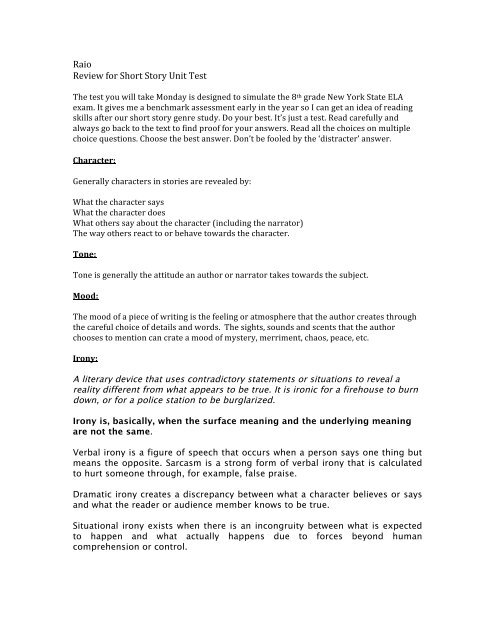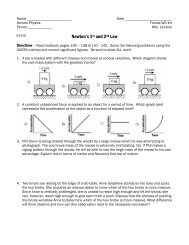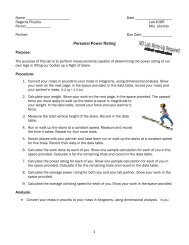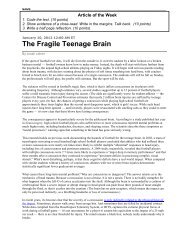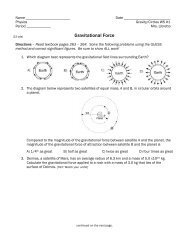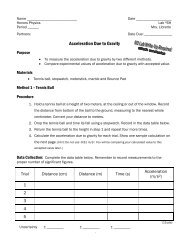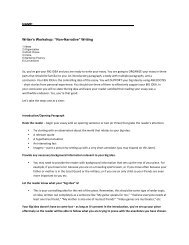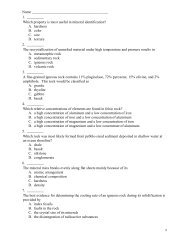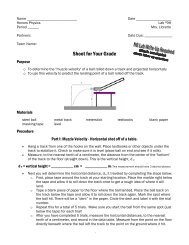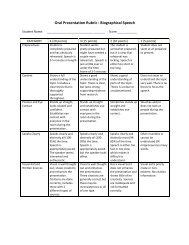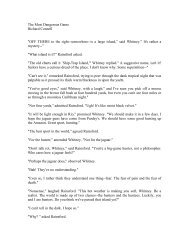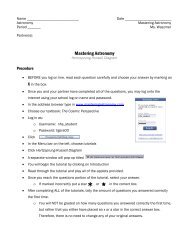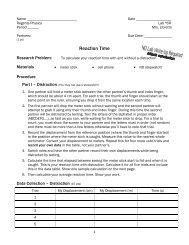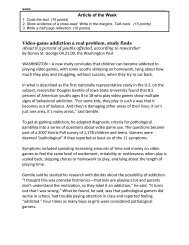Raio Review for Short Story Unit Test
Raio Review for Short Story Unit Test
Raio Review for Short Story Unit Test
Create successful ePaper yourself
Turn your PDF publications into a flip-book with our unique Google optimized e-Paper software.
<strong>Raio</strong> <br />
<strong>Review</strong> <strong>for</strong> <strong>Short</strong> <strong>Story</strong> <strong>Unit</strong> <strong>Test</strong> <br />
The test you will take Monday is designed to simulate the 8 th grade New York State ELA <br />
exam. It gives me a benchmark assessment early in the year so I can get an idea of reading <br />
skills after our short story genre study. Do your best. It’s just a test. Read carefully and <br />
always go back to the text to find proof <strong>for</strong> your answers. Read all the choices on multiple <br />
choice questions. Choose the best answer. Don’t be fooled by the ‘distracter’ answer. <br />
Character: <br />
Generally characters in stories are revealed by: <br />
What the character says <br />
What the character does <br />
What others say about the character (including the narrator) <br />
The way others react to or behave towards the character. <br />
Tone: <br />
Tone is generally the attitude an author or narrator takes towards the subject. <br />
Mood: <br />
The mood of a piece of writing is the feeling or atmosphere that the author creates through <br />
the careful choice of details and words. The sights, sounds and scents that the author <br />
chooses to mention can crate a mood of mystery, merriment, chaos, peace, etc. <br />
Irony: <br />
A literary device that uses contradictory statements or situations to reveal a<br />
reality different from what appears to be true. It is ironic <strong>for</strong> a firehouse to burn<br />
down, or <strong>for</strong> a police station to be burglarized.<br />
Irony is, basically, when the surface meaning and the underlying meaning<br />
are not the same.<br />
Verbal irony is a figure of speech that occurs when a person says one thing but<br />
means the opposite. Sarcasm is a strong <strong>for</strong>m of verbal irony that is calculated<br />
to hurt someone through, <strong>for</strong> example, false praise.<br />
Dramatic irony creates a discrepancy between what a character believes or says<br />
and what the reader or audience member knows to be true.<br />
Situational irony exists when there is an incongruity between what is expected<br />
to happen and what actually happens due to <strong>for</strong>ces beyond human<br />
comprehension or control.
Theme:<br />
The Literary Element of Theme<br />
Theme is:<br />
• the central, underlying, and controlling idea or insight of a work of<br />
literature.<br />
• the idea the writer wishes to convey about the subject—the writer’s<br />
view of the world or a revelation about human nature.<br />
Theme is NOT:<br />
• expressed in a single word<br />
• the purpose of a work<br />
• the moral<br />
• the conflict<br />
Identifying the Theme in Five Steps<br />
To identify the theme, be sure that you’ve first identified the story’s plot, the<br />
way the story uses characterization, and the primary conflict in the story.<br />
Use these steps to determine the theme <strong>for</strong> a work:<br />
1. Summarize the plot by writing a one-sentence description <strong>for</strong> the<br />
exposition, the conflict, the rising action, the climax, the falling action,<br />
and the resolution.<br />
2. Identify the subject of the work.<br />
3. Identify the insight or truth that was learned about the subject.<br />
• How did the protagonist change<br />
• What lesson did the protagonist learn from the resolution of the<br />
conflict<br />
4. State how the plot presents the primary insight or truth about the<br />
subject.<br />
5. Write one or more generalized, declarative sentences that state what<br />
was learned and how it was learned.<br />
Theme Litmus <strong>Test</strong><br />
• Is the theme supported by evidence from the work itself<br />
• Are all the author’s choices of plot, character, conflict, and tone<br />
controlled by this theme.


